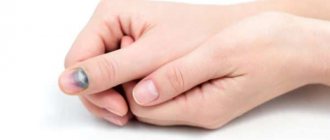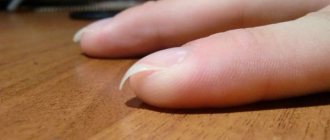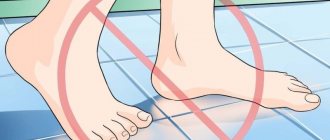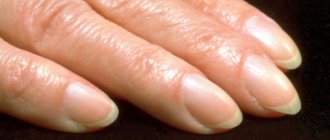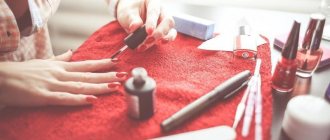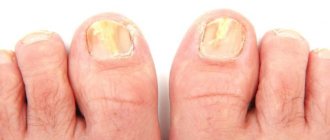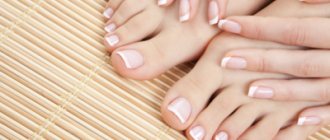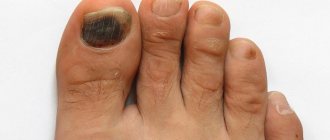What types are there?
Depending on the severity of the course, two stages are distinguished:
- Early or initial, when thinning and flattening of the nail plate are noted. A small depression appears in the center, color and smoothness are preserved;
- Late, in which the subungual space changes, the nail becomes fragile, the free edge of the plate bends upward. The nail plate crumbles at the edges, but retains its natural color and smooth surface.
Depending on the cause, koilonychia can be:
- Hereditary or congenital, develops as a result of gene mutations. Dystrophy is inherited; many family members have it;
- Acquired, formed during life under the influence of external factors or internal diseases;
- Idiopathic, when the causes cannot be determined.
Classification of fungal infections
In childhood, pathology is more common on the legs than on the hands. Depending on the clinical manifestation, the following forms of damage are distinguished:
- distal-lateral - the infection affects the nail bed and the lower part of the plate, which leads to thickening of the nail fold, sometimes leading to nail detachment;
- white superficial type - affects the upper layer of nail tissue, often observed on the 1st and 5th toes, which is associated with their high traumatization by shoes;
- proximal - the fungus penetrates under the nail fold, then into the matrix, so dystrophic changes affect the entire nail, cracks, irregularities and grooves appear on it, which can lead to its complete destruction;
- endonyx - a type of lesion in which there is no inflammatory reaction or hyperkeratosis, the nail plate becomes cloudy, turns white, and thickens slightly;
- total dystrophy - becomes a consequence of any of the forms described above, all elements are damaged, the nail disintegrates due to damage to the matrix, growth slows down.
Nail fungus in children may be accompanied by skin inflammation
The shape of the lesion is also determined by changes in the nail plate. The normotrophic type is characterized by maintaining normal thickness, transparency and color change, white stripes appear on the surface, and the plate becomes brittle. Sometimes yellowing of the nail is observed, and serous fluid is released from under it.
The hypertrophic type of lesion is rare in children; it is characteristic of the long-term course of onychomycosis. The nail plate thickens due to hyperkeratosis; this form can persist even several months after completion of therapy.
The onycholytic type is characterized by a gradual thinning of the nail and a change in color to dirty gray.
Causes of koilonychia
The mechanism of formation of spoon-shaped nails has not been studied enough, so it is difficult to unambiguously explain the origin of koilonychia. It is known that it is a symptom of other diseases; it can be caused by various reasons.
In the acquired form, the basis of the pathology is a violation of keratinization or deposition of keratin in the nails, which causes a deterioration in protein metabolism and tissue nutrition. Such changes occur under the influence of internal or external factors. As a result, the nail, which normally consists of several layers of keratinized skin cells, becomes single-layered, thin, and easily deformed.
External factors
External causes leading to koilonychia include:
- nail plate injuries;
- contact with harmful chemicals, petroleum products;
- frequent intense exposure to ultraviolet radiation;
- sudden changes in temperature;
- fungal infection (onychomycosis).
Koilonychia is often provoked by working with detergents and cleaning products without protective gloves, continuously wearing artificial nails, and constantly using acetone remover to remove nail polish.
There are high risks of developing the disease in people living at an altitude of more than 3000 m above sea level. This is explained by a decrease in blood oxygen saturation and its supply to organs and tissues. When oxygen levels are low, the production of erythrocytes (red blood cells) increases, which increases iron consumption, leading to iron deficiency.
Koilonychia is often observed in people of certain professions. For example, in people working with mineral oils and organic solvents, which provoke contact dermatitis. And also in people who are subject to constant injury or experience stress in their fingers. The disease occurs among hairdressers who work with ammonium thioglycolate for perming hair.
Internal factors
Among the internal factors, spoon-shaped deformation of the nail plate is caused by:
- Iron-deficiency anemia;
- endocrine disorders;
- psoriasis, lichen planus, systemic lupus erythematosus;
- lack of metalloenzymes and sulfur-containing amino acids in the body;
- changes in the nail matrix caused by decreased blood flow due to Raynaud's syndrome and vascular pathologies;
- endocrine pathologies (diabetes mellitus, hypothyroidism, hyperthyroidism).
- chemotherapy or radiation therapy for cancer;
- nutrient absorption disorders;
- celiac disease;
- deficiency of protein, B vitamins, vitamin C, minerals (zinc, copper, selenium) caused by poor nutrition, vegetarian diet.
A common cause of acquired koilonychia is iron deficiency anemia. With it, the content of hemoglobin and red blood cells in the blood decreases. Spoon-shaped nails occur in 5.4% of patients with iron deficiency.
Iron deficiency anemia is caused by:
- insufficient intake of folic acid, protein, vitamin C;
- impaired absorption of iron from food;
- iron deficiency in the diet;
- internal bleeding, including heavy, prolonged menstruation in women.
Iron deficiency anemia can be a symptom of other diseases. It is present in Plummer-Vinson syndrome and sideropenic syndrome.
Koilonychia in sideropenic syndrome is caused by iron deficiency in tissues.
The activity of important enzymes decreases and the following severe symptoms appear:
- perversion of taste, smell;
- muscle weakness, atrophy due to deficiency of myoglobin and tissue respiration enzymes;
- dystrophic changes in skin, hair, nails;
- inflammation in the oral cavity, gums;
- atrophy, dryness of the gastrointestinal mucosa, difficulty swallowing food;
- atrophic gastritis, enteritis;
- pronounced blueness of the sclera;
- problems with urination, etc.
In Plummer-Vinson syndrome, koilonychia is observed in 37–50% of cases.
It is rare and manifests itself in the form of three main symptoms:
- dysphagia or impaired swallowing function;
- Iron-deficiency anemia;
- stricture or narrowing of the esophagus due to the formation of scar tissue.
Plummer-Vinson syndrome precedes cancer of the cervical esophagus; it is important to detect it promptly and begin to treat it.
Hereditary koilonychia
Associated with changes in genes responsible for the synthesis of certain types of keratins in the stratum corneum. Against the background of the mutation, the cells of the surface layer of the epidermis are less able to absorb the protein necessary for the formation of a normal stratum corneum. There is a thinning of the plate and a loss of strength, which leads to deformation of its central zone.
Hereditary koilonychia is found in the following genetic diseases:
- Hemochromatosis. It manifests itself as a violation of iron metabolism, its accumulation in the tissues of the liver, myocardium, spleen, skin, and endocrine glands. Koilonychia is present in 50% of patients with hemochromatosis. Signs of the disease can appear at any age, but more often it occurs at 30–40 years of age;
- Nail-patella syndrome, a rare hereditary disease characterized by abnormalities of bones, joints, fingernails, toenails, and kidneys.
Color change
Normally, a child’s nails are a soft pink color with a pronounced whitish hole at the base. What factors change their color? What might a certain color indicate?
White
Sometimes white spots appear on the child's fingernails or toenails. This condition is medically called leukonychia.
There are several forms of it:
- total, the entire nail plate becomes white;
- stripe-like, transverse white stripes are formed;
- dotted, white dots appear on the child’s nails;
- limited, manifests itself in the form of elongated spots of small size.
People believe that white spots occur due to excessive intake of vitamins and minerals, but in fact this is not the case. The causes of white spots on a child’s nails are long-term minor injuries, mechanical damage to the growth zone, and the habit of biting nails. Such changes may appear on your feet due to improperly selected shoes. White spots on a child's nails may be a manifestation of a fungal infection (onychomycosis).
Among systemic diseases, leukonychia is caused by iron deficiency anemia, pathologies of the liver, heart, intoxication, impaired protein digestion, psoriasis, and eczema.
The white spots and stripes on a child’s nails themselves do not require treatment.
In most cases, this is a temporary cosmetic defect that disappears as the nail plate grows. If they appear again, you need to consult a doctor, undergo an examination, and find out their cause.
Yellow
Yellow color is almost always a sign of onychomycosis. This disease is much less common in children than in adults. But it cannot be ruled out. Another yellow color is characteristic of psoriasis.
In addition, the yellow color of a child’s nails is provoked by abnormalities in the liver with impaired bilirubin metabolism, jaundice, pathologies of the endocrine and lymphatic systems, and chronic inflammation of the mucous membrane of the paranasal sinuses.
Red
The red coloration of a child's nails is associated with inflammatory processes in the soft tissues of the nail bed, impaired blood flow in the capillaries, and dilation of small vessels. It is often observed with high temperature and fever.
Red or brown stripes or dashes are the consequences of damage to small vessels under the nail plate that occur as a result of injury.
Black
One of the common causes of black color is household injuries. For example, if a child pinches a finger with a nail in an interior or entrance door. After a severe bruise, swelling occurs, hemorrhage into the soft tissues of the nail bed, and a hematoma forms. After 10 hours, the child's nail turns black or blue, depending on the severity of the injury.
To help your baby, immediately after an injury, apply a cold compress to the sore spot or place the injured finger under a stream of cold water from the tap.
The resulting hematoma resolves within 4 to 6 weeks.
Koilonychia in children
Koilonychia is found in 33% of newborns. Typically it affects the big toe. After 9 years, as the nail plate thickens, this deformation goes away on its own, and the nail takes on the correct shape. In this case, it is not considered a deviation, but is considered as a normal development option.
The most common causes of koilonychia in a child include iron deficiency and injury. Injuries can be caused by the habit of sucking toes or shoes that fit too tightly. If the influence of these factors is eliminated, the shape of the nail plate quickly returns to normal.
What signs are characteristic of koilonychia?
The disease can affect only one finger, several at the same time, or even all at once. The main risk factor for its development is thinning of the nail plate. The second and third fingers are most often affected. It rarely occurs on the toes. Damage to the toenails is accompanied by inconvenience when putting on socks and tights, leads to cracks in the nail when squeezed by shoes, and detachment from the nail bed.
What is characteristic of koilonychia? Apart from changing the shape of the nails, koilonychia does not cause any other unpleasant sensations. It manifests itself only as an aesthetic defect of the nail plates. Not accompanied by pain, itching, redness, inflammation, swelling. Sometimes subungual hyperkeratosis and periungual peeling of the skin are formed.
What koilonychia looks like is shown in the photo:
If the deformation is associated with internal causes, then what symptoms will there be with koilonychia? With anemia, for example, a person is worried about fatigue, shortness of breath, dizziness, and pale skin. The list of symptoms depends on the root cause of the disease. The more the underlying pathology worsens, the greater the degree of damage to the nail plate.
How is the diagnosis done?
To confirm koilonychia, you need to consult a podologist or dermatologist. Usually, making a diagnosis is not difficult; a simple examination is sufficient. Changes in shape are best seen when viewed from the side.
If koilonychia is suspected, a water test is performed. Using a syringe, pour a few drops of water onto the surface of the nail in the center. If the drops do not roll or spread, then this is a sign of spoon-shaped deformation.
Sometimes koilonychia are detected by chance during a general examination. To explain their origin, an examination is prescribed.
To find out the reasons, the doctor will ask the patient:
- how he takes care of his nails, eats;
- what symptoms are still bothering you?
- were there any injuries in the area of the upper phalanx of the fingers;
- Do family members have similar disorders?
A full examination by specialized specialists and tests may be required. This includes consultation with a gastroenterologist, endocrinologist, hematologist, and geneticist. The tests include a general and biochemical blood test, tests for minerals, and hormones.
It is important to exclude a fungal infection, which can cause koilonychia. To do this, a microscopic examination of the scraping of the nail plate is performed.
Types of onychodystrophy
Dystrophy of the stratum corneum is classified according to the symptoms and external signs that accompany the disease.
All pathologies are divided into several groups, the most common of which are:
- A transverse groove is a pathology in which a stripe or depression appears between the lateral nail folds.
- Longitudinal grooves are deformation of the horny plate due to poor circulation.
- Onychorrhexis is the breaking of the nail in the longitudinal direction.
- Onychoschisis - transverse clefting.
- Brittleness, the most common type of nail dystrophy diagnosed in women, occurs due to hormonal changes.
- Onycholysis is the detachment of the stratum corneum from its bed.
- Onychomadesis is the departure of the horny covering from the bed not in the area of the lateral ridges, but from the center.
- Koilonychia is a depression of the horny covering in the center of the plate like a saucer.
- Thimble-like wear is the appearance of frequent depressions (pits) across the entire surface of the nail plate due to dermatoses and other systemic diseases.
There are other types of pathologies that are considered a manifestation of nail dystrophy, but they are less common.
How to treat koilonychia?
Treatment of nail koilonychia consists of eliminating the cause that caused it, correcting concomitant pathology, and strengthening the plate.
In case of injury or contact with harmful chemicals or detergents, local anti-inflammatory and regenerating agents are used. The specific medications, regimen, and duration of their use are selected by the doctor.
If the cause of spoon-shaped deformity is iron deficiency anemia, the diet is adjusted, enriching it with foods containing iron, or a course of iron-containing medications is prescribed. Treatment should be supervised by a doctor. Excess iron is fraught with serious health problems, so you cannot independently diagnose yourself and choose medications for the treatment of koilonychia based on advice on forums.
Iron-rich foods include:
- bitter chocolate;
- beans, lentils, chickpeas;
- beef liver;
- spinach;
- baked potato;
- buckwheat;
- cashew nuts;
- raisin.
Vitamin C improves iron absorption, so it is recommended to enrich your diet with foods containing this vitamin.
Restoring the normal level of iron in the blood helps to get rid of koilonychia, but correcting the shape of the nails takes 4 to 6 months. This time is necessary for the new plate to grow. Toenails take about 12 – 18 months as they grow more slowly.
The acquired form of the disease is almost always reversible. There is no effective treatment for the genetic and idiopathic form. To strengthen the nail plate, the doctor will prescribe proper care, vitamin and mineral complexes for nails containing zinc, iron, calcium, and silicon.
How to care?
To improve the condition of nails with koilonychia, proper care is important, because thin plates are especially vulnerable to the negative effects of external factors and require additional protection and care.
What can be done?
- Wear rubber gloves when working with detergents, cleaning agents and other aggressive compounds;
- Use a soft brush to keep your nails clean;
- Moisturize your hands and feet with cream daily;
- Trim your nails only after a bath or shower when they are soft;
- Keep your nails trimmed short so as not to catch or bend them;
- Choose shoes that do not squeeze your toes;
- See a doctor immediately if there is redness or inflammation;
- Avoid nail polish removers containing acetone;
- Do not wear gel polish or use regular decorative varnish until koilonychia is cured.
Problems with nails often indicate that something is wrong with the body; they cannot be ignored. In the case of koilonychia, this may be a sign of serious systemic disorders that require medical attention. You should not delay visiting a specialist, because there is a risk of wasting time and worsening the condition.
podology koilonychia
Causes
In addition to injuries, the following factors can lead to bent nails:
- diseases (both of the body in general and of the nails in particular);
- lack of vitamins and microelements, as a result of which the nail plates form incorrectly or not quickly enough;
- wearing uncomfortable or ill-fitting shoes;
- anatomical defects in the development of the nail bed and nail plate.
If your nails grow up or curl down
It makes sense to fight a defect only if the deformity is acquired and not congenital, which only a doctor can tell you about. If you have just identified the problem, you can try to correct the situation:
- change your baby’s shoes to looser ones, if possible, let the child spend as much time as possible barefoot;
- adjust the baby’s diet, ensure that a sufficient amount of nutrients enters the child’s body;
- Take baths several times a week to help strengthen the nail plate - add sea salt and a few drops of iodine to warm water;
- rub vitamin E into the nail plates of your toenails and cuticles, which will improve their condition.
If you do not notice positive changes within several weeks, then you cannot do without the help of a doctor.
If your nails curl at the sides
If your nails curl at the sides, this is most likely a sign of ingrown nails. Ingrown nails can be caused by improper nail trimming. To learn how to properly trim your child's toenails, ask your pediatrician to show you how. Remember - toenails are cut at a right angle, using a special children's tool - nippers or scissors.
The best thing you can do if you notice any deformity in your child's toenails is to see a doctor. A pediatrician can also help solve the problem, but the best option is to find a specialist podiatrist who specializes in the treatment of diseases of the foot and toenails.
In any case, do not try to eliminate the defect using drastic methods; this can lead to serious injury and the need for long-term treatment.
